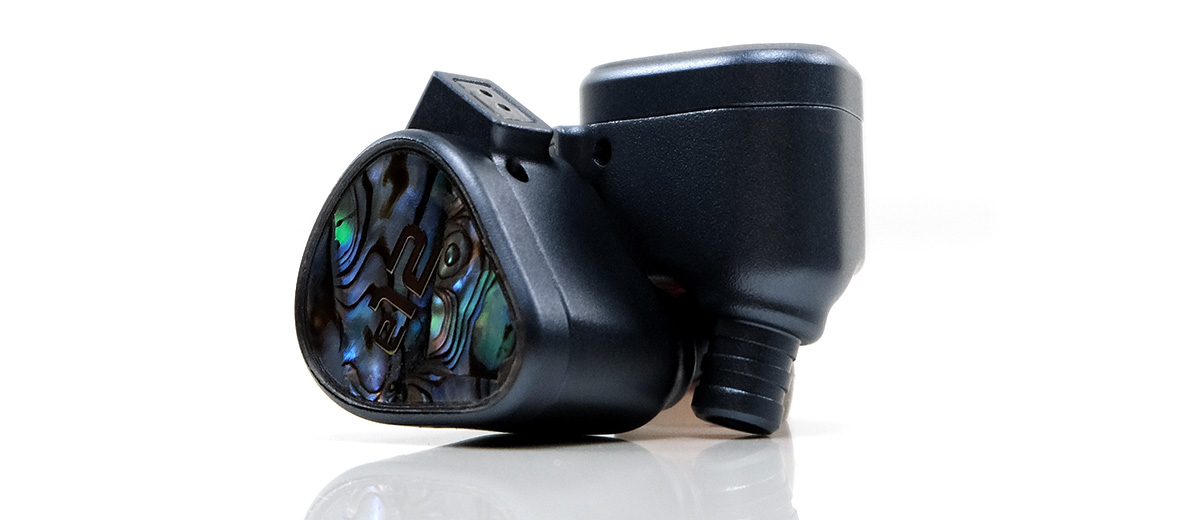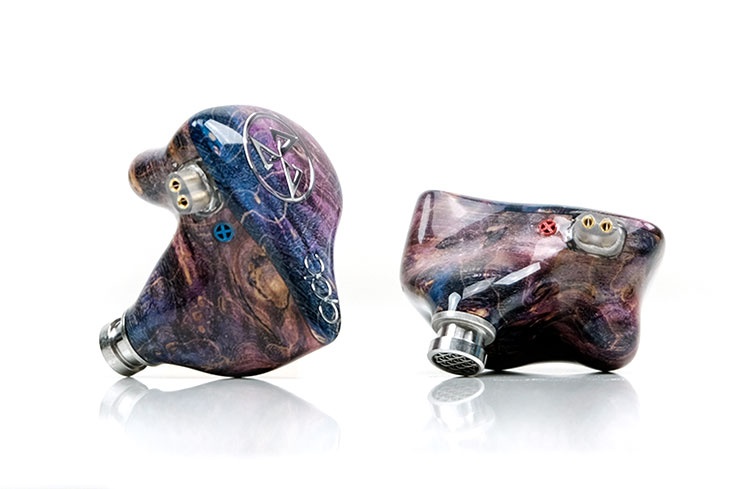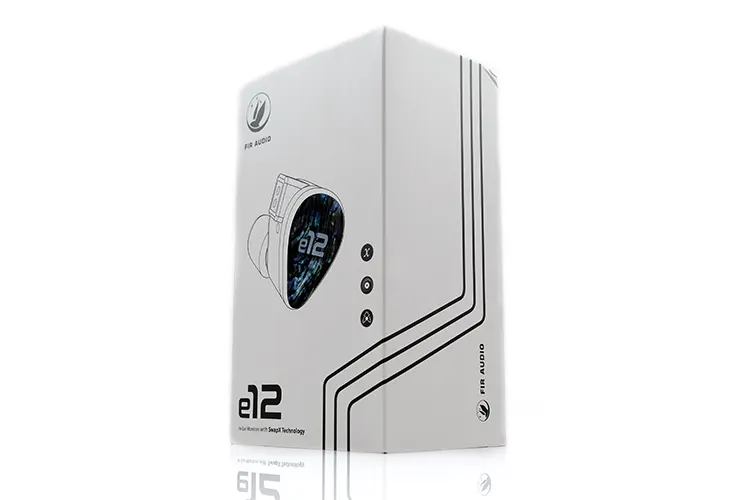Select Comparisons
The following comparisons to the FIR Audio e12 were completed using a mix of the HiBy R8 II and the iBasso DX320 MAX Ti as both source and amplification.
Softears Twilight
The Softears Twilight was launched in late 2022 and reviewed by us in early 2023. You can read more about the Twilight in our full review here.
Technical
Like the e12, the Twilight is a single dynamic driver IEM though slightly smaller at 10mm. It uses a DLC or Diamond-Like Carbon dome with a FreeEdge PU or polyurethane suspension supported by a 0.35mm Daikoku high-tension voice coil.
Since they are both dynamic in design, both IEMs have evolved air management systems with the e12 using ATOM (internal). Softears focuses more on the volumetric size and damping of the internal acoustical space. Hence, one would argue, its more unusual external shape.
The Softears Twilight is rated at 16Ω impedance which is an exact match for the e12’s load measurement with a sensitivity rating of 116dB @1kHz.
FIR does not produce SPL numbers for their IEMs but I can tell you that the e12 does seem a little bit more sensitive compared to the Twilight using a low gain balanced output mode from the R8 II.
Design
The Twilight has a very radical design compared to the e12. The form factor is a rectangular wedge to the front and the main driver housing combined with the nozzle running perpendicular underneath it.
Does it work? Kind of, you do have to twist it to a vertical position in your ear if you are not aware whereas the e12 is a very familiar fitting. The comfort level is better than I expected but like the e12 the choice of tips will play a major role since both use CNC-machined aluminum alloy which is robust but not as pliant as resin for isolation.
The isolation on the twilight is slightly lower using the stock tips but only slightly. With foam tips, the e12 is probably the better choice for blocking out noise. I think the final decider is the e12’s shell width which covers more of the concha basin compared to the narrow and tall Twilight form factor.
Aesthetically, the SwapX plates bring an additional dimension to design choices for the e12 that the Twilight lacks. However, Twilight is so unusual-looking that it’s almost a topic of discussion in its own right.
The Twilight’s 1.2m 6N OFC cable with a 4-core geometry is decent but a step behind the e12’s balanced terminated 48″ 26AWG cable with its 8-wire geometry and pure silver and copper shielding. I will give credit to Softears for throwing in a 4.4mm to 3.5mm conversion short cable though.
Performance
Picking one over the other will come down to a preference for how you like your bass to sound, smooth and punchy, or weighty and explosive.
It may also depend on how much vocal preference you want – smoother and neutral compared to crystal clear and forward. And finally, do you want something natural and inoffensive for the highs or something sparkling and energetic?
All of the former descriptions above apply to the Twilight and all of the latter to the e12. It just goes to show that one dynamic driver can sound nothing like the other and in the case of the e12, clean treble is not the preserve of BA drivers.
Speaking of BA drivers, the irony of the Twilight tuning is the attenuated sub-bass which is more akin to the amplitude of a couple of decent dual BA woofers.
Not that the decay is as dry, it still displays that natural linger of a dynamic driver but rather if you are expecting depth and rumble, then the e12 will shovel it to you in a concussive fashion compared to the politer Twilight.
However, to keep the separation and presence as strong as possible the e12 dips harder in the lower-mids and pushes further up on the 1-3k to counter the growl of those lows. You get glorious bass and forward vocals but a cleaner lighter timbre on the lower mids and a lot more contrast through the upper mids around 5k.
The Twilight is more relaxed from 1k onwards and carries more warmth through the lower-mids onwards. It’s slightly smoother and richer but with less treble energy to brighten up percussion and upper vocal registers.
HIFIMAN RE2000
Sadly, there is no Svanar here with me as Louis did the review but we have the RE2000 Gold here. Launched in 2017, it still retails for $2000 on the HIFIMAN website which is the same price as the Svanar.
Technical
Again, both IEMs are single dynamic drivers with the RE2000 using a smaller 9.2mm version compared to the e12’s 12mm design.
The RE2000’s driver is significant because it was the debut of HIFIMAN’s Topology diaphragm which is now an integral part of their dynamic driver line-up in both IEM and headphone form factors.
Topology is a nanoparticle coating applied to the driver’s surface in distinct geometric patterns to control the final sound signature on a more granular level compared to regular IEM diaphragms.
The e12’s granular tuning is more about what’s around the driver including the coupling to the shell for its Tactile Bass Technology as well as the ATOM filter system as two standout examples.
The Re2000 is rated at a very high 60Ω impedance compared to just 16Ω for the e12. With an SPL of 103 dB/mW @1kHz the RE2000 is also much less sensitive by up to 50% (volume steps) in the real-world testing with a HiBy R8 II in SE low gain mode.
Design
Like the Twilight, the RE2000 is another unique design compared to the e12’s more standard-looking teardrop shape.
Despite being the heavier of the two, the 24k gold-plated RE2000 form factor is a lot smaller compared to the e12. However, it’s the fitting where the unique shape combined with the weight presents some challenges, more so than the e12.
The elongated barrel combined with the forward-facing connector system and a very short nozzle means seal and comfort levels will be driven by the tip you choose.
I tend to find that I need a very wide or deep multi-flange tip or a large foam version to get a good fit with average isolation from the RE2000. Whereas with the e12, I can improve isolation marginally with foam over silicone but my choice of tip is more about the influence on the sound quality.
I have to say the e12 cable is a bit of a step up on the RE2000 stock cable. HIFIMAN has been using this silver-coated single crystalline copper wire a lot over the years and whilst I have no issues with the performance as such I do find its black rubber jacket finishing to be a bit cheap looking.
Not to mention it’s 3.5mm SE only with a regular 2-pin connector housed in a fiddly recessed socket system that makes cable rolling a bit more challenging due to how it requires a distinct forward-curving motion from its socket.
The e12 cable design is elegant, attractive, of a higher grade of wire, and fitted with a more modern 4.4mm plug. It also has a standard flush mount from its SwapX Assembly socket making it universal to most compatible cables.
Performance
On paper these two IEMs graph not too far apart with a mild V-shaped response curve and good extension in the lows. The key difference is the level of warmth and how far forward the mids are compared when to each other.
I would also argue that there may well be a technical difference in the tautness of the e12 driver diaphragm along with the Tactile Bass technology that improves its definition and slam compared to the slightly softer and more relaxed RE2000 performance.
There certainly seems to be a more ‘driven’ presentation in the e12 in general whereas the RE2000 sounds weighty but languid and softer, particularly through the mids from 1-4k which is more recessed compared to the e12’s more aggressive 1-2k imaging.
Vocals are more forward on the e12 and they also pick up a bit more treble overtones giving them a cooler overtone. The RE2000 has some minor peaks in the treble but it’s more attenuated compared to the e12 tuning and doesn’t quite bear down on the upper-mids as much.
Both IEMs are macro performers for soundstage but the e12 does enhance the perception of its low and highs better with stronger dynamics and better definition. It also stretches the stage depth a bit more from front to back compared to the RE2000.
I think if you want something smoother for vocals and percussion and less energy through the mids and highs then the RE2000 is the more forgiving of the two.
qdc Dmagic 3D
The qdc Dmagic 3D was launched in late 2020 with our review published in early 2021. At a time when multi-dynamic driver IEMs were rare and not very well implemented the 3D’s excellent tuning was like a breath of fresh air. They still sell at Musicteck USA if you want to check it out.
Technical
The biggest difference here is the use by qdc of no less than 3 slightly smaller dynamic drivers with a 3-way crossover inside the Dmagic 3D instead of just the one large 12mm version inside the e12 to cover everything.
The configuration includes a coaxial implementation consisting of a 10mm graphene vibrating diaphragm and a titanium-plated vibrating diaphragm compound dual dynamic driver for the lows and mids. A smaller 8mm compound vibrating diaphragm is used for the highs.
qdc does mention some attention paid to the acoustical cavity design to allow for a triple dynamic driver implementation but not as specific as the e12’s ATOM filter or the way FIR has coupled the driver to the shell for additional effect.
The Dmagic 3D has a slightly lighter load at 13.5Ω compared to the e12’s 16Ω rating but at 98 dB/mW @1kHz the qdc IEM is the less sensitive of the two IEMs in my real-world testing with the iBasso DX320 MAX Ti using a balanced gain stage 1 output connection.
Design
I have to give props here to qdc for the beautiful design of the Dmagic 3D. It lacks the unique SwapX plates of the e12 so there is no ability to customize it but in some ways, you do not need to.
The aesthetic is a gorgeous base wood with a stabilizing resin and a lot of dye mix-and-match to get a beautiful deep, richly diverse nebula swirl design.
It is more quasi-custom, not as rigid as the CNC aluminum of the e12 so perhaps not as robust but its fitting is superior, and the level of passive isolation is slightly better also, even with silicone tips.
Where the problem arises with the Dmagic 3D is the reverse polarity 2-pin socket system which means you need adaptors to cable roll. That will create some bulk on the connector socket end and some additional costs.
The accompanying 26AWG copper and silver 8-core parallel wire, (4×4), geometry stock cable, though lightweight, is relatively basic in its finishing. It does come with an interchangeable connector system though so connectivity for SE and balanced is not an issue.
I do wish qdc would adopt a standard polarity connector system, similar to the e12, though for the e12 I have no real desire to roll cables as the finishing on it is very good.
Performance
Two phrases come to mind when I am comparing these two IEMs, space and Les Paul. So, what do I mean by that?
The e12 creates a stronger perception of space and uses it better with superior dynamic range, depth, and height. The Dmagic 3D creates some beautiful analog-sounding lower-mids rich and rounded and perfectly suited for Les Paul guitar chords hooked up to some classic Marshall tube amps.
In a way, the e12 is perfect for modern rock and pop. It excels with sub-bass power and injects a solid fundamental into kick drums, or almost any lower register note.
The Dmagic 3D cannot compete with its attenuated sub-bass performance. It leans more towards a mid-bass punch and upper-bass bloom with some bleed into the lower-mids. That is where the Les Paul rock sound thrives and where the e12 sounds leaner and cooler in tone.
Granted, the e12 has a stronger level of clarity. That space it generates from its stretched 1-4k region and stronger set of highs creates a better sense of separation. The cleaner note tone attacks the senses a bit more whereas the Dmagic 3D is slightly duller and less clear in its presentation over the same region.
The 3-8k region of the Dmagic 3D can be highly tip-dependent also. With the dual flange tips, the timbre veers to the natural to slightly euphonic side. With the single-bore silicone tips, you get more of an ethereal glassy tone to percussion and vocals which I didn’t find appealing.
The e12 also shapes and changes with its tip selection. It can sound sharper in the higher and upper mids with the silicone tips so I find myself using the stock foam tips to get a more natural tonal quality.
Our Verdict
The FIR Audio e12 is a high-energy dynamic driver IEM with addictive ‘bangin’ lows and a clean set of mids and highs. It is easy to drive from almost any source but sounds optimal with a neutral DAP or dongle that offers excellent dynamic range.
The only caveats I had were for those sensitive to treble. They might want to swap out the silicone for the foam tips to balance out the potential for edginess from the e12 upper-mids and highs.
Otherwise, the aesthetics and design are solid and the stock cable is above average. It’s also a clever touch from FIR Audio to blend some of their custom house design strengths into the e12 offering with SwapX interchangeable plates.
From a personal perspective, I love IEMs like the e12 that nail their colors to the flag and just let rip. There is nothing better than packing a joyful-sounding monitor in your travel bag with plenty of casual audio tracks and letting your foot off the aural brakes, so to speak.
FIR Audio Electron 12 (e12) Technical Specifications
- Single 12mm Electro-Dynamic Driver with Tactile Bass
- Freq. Range: 20-20kHz
- Impedance: 16Ω
- Isolation: -17 dB





